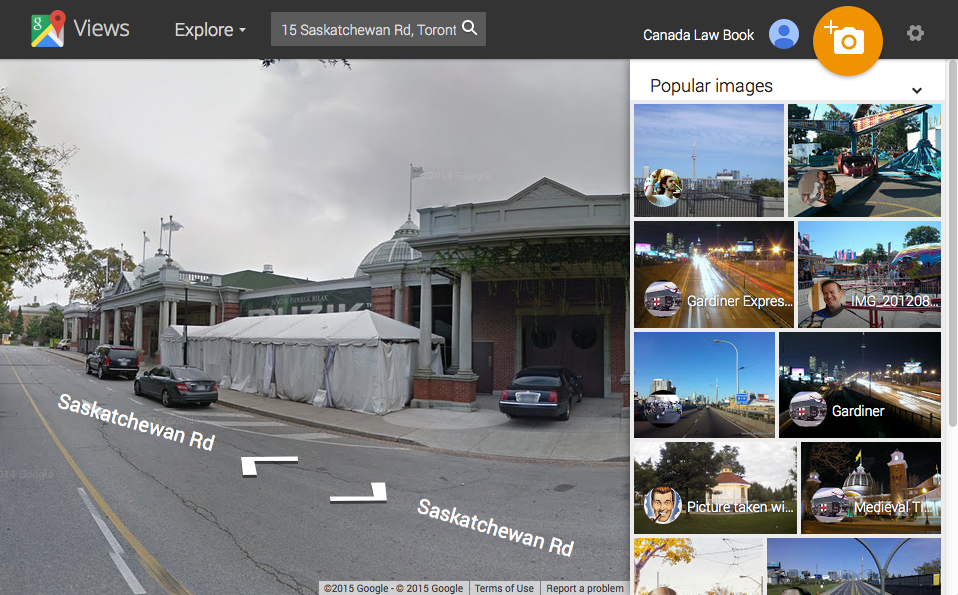The Ontario Superior Court has ordered a new trial in an assault case because a judge looked up and questioned a witness about information from Google Street View on his own initiative.

“Images and maps downloaded from Google Maps are now very common in criminal trials and often accepted as authoritative. . . . But what happens when a trial judge, during the course of a criminal trial, uses an image from Google Street View that he himself has downloaded to make an adverse finding of credibility against an accused person?” wrote Superior Court Justice Robert Goldstein in setting out a key question in the summary conviction appeal in
R. v. Ghaleenovee last week.
The case dealt with a charge of assault causing bodily harm in relation to an incident outside the Muzik nightclub in Toronto in December 2011. According to Goldstein’s summary of the allegations, a man approached the victim, Pouneh Ahmadi, in an angry manner and punched her in the face for no apparent reason.
When a police officer who arrived on the scene observed a cut on defendant Soheil Ghaleenovee’s knuckle, the defendant told him he had cut his hand on the fence at the nightclub and mentioned an earlier incident with a bottle. During his testimony, Ghaleenovee admitted to getting into a fight with someone else but denied punching Ahmadi.
After Ghaleenovee testified, the trial judge, whom Goldstein’s ruling didn’t identify, accessed a Street View image of the nightclub showing the fence and asked another witness called by the defendant’s counsel about it. He didn’t put the image to Ghaleenovee but relied on it, in part, to make an adverse finding of credibility against him.
“He offers an explanation for how he got the cuts to his knuckles, but it does not seem very likely that he could have cut his hand on the fence in the way he described, or at all,” the trial judge said during the proceedings.
“The fences in question are tubular, they have corners, but not the kind of corners that anybody could cut their hands on, particularly in the way described by Mr. Ghaleenovee.”
The trial judge ended up finding him guilty.
“In my respectful view, by doing so he compromised the fairness of the trial,” wrote Goldstein of the trial judge’s actions involving the Street View image.
In coming to his conclusion, Goldstein, citing one case from the Ontario Court of Appeal as well as other trial decisions, noted judges could in fact access Google maps to take judicial notice of facts. But the question, he found, is when do the judge’s actions cross the line into conducting an investigation and usurping the role of counsel. In this case, a major concern was not putting the image to Ghaleenovee.
“A reasonable person would consider it unfair that Mr. Ghaleenovee was never asked to comment on the image,” wrote Goldstein.
“I might add that the trial judge’s comment was also problematic because of his observation — made without expert evidence — that Mr. Ghaleenovee’s cuts on his knuckles were consistent with tooth marks.”
Criminal defence lawyer Daniel Brown notes the case deals in part with the scope of judicial notice when it comes to accepting facts generally accepted to be true. When it comes to Google maps, according to Brown, there’s a general acceptance that they’re accurate. But in this case, he says, the trial judge went even further.
“That’s problematic for a few reasons,” he says, noting the Street View image may now be out of date. “It very well may be that the fence was different at the time,” says Brown.
“It’s in some cases perfectly appropriate for a judge to rely on things we all know are true, but in this case the judge went too far,” he adds, citing the need for the trial judge to have at least put the issue to Ghaleenovee.
But is it OK for a judge to go on Google Street View at all?
“I don’t think so,” says Brown, citing other cases that have taken judges to task for doing their own research. (See:
B.C. judge admonished for doing too much homework)

 “Images and maps downloaded from Google Maps are now very common in criminal trials and often accepted as authoritative. . . . But what happens when a trial judge, during the course of a criminal trial, uses an image from Google Street View that he himself has downloaded to make an adverse finding of credibility against an accused person?” wrote Superior Court Justice Robert Goldstein in setting out a key question in the summary conviction appeal in R. v. Ghaleenovee last week.
“Images and maps downloaded from Google Maps are now very common in criminal trials and often accepted as authoritative. . . . But what happens when a trial judge, during the course of a criminal trial, uses an image from Google Street View that he himself has downloaded to make an adverse finding of credibility against an accused person?” wrote Superior Court Justice Robert Goldstein in setting out a key question in the summary conviction appeal in R. v. Ghaleenovee last week.